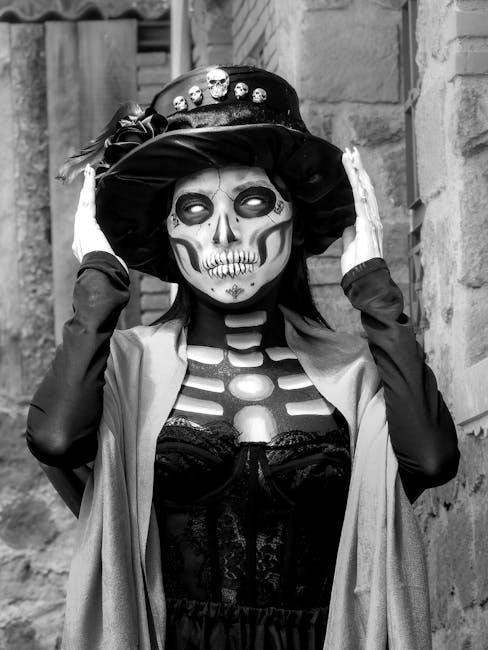the lady of the tiger pdf
The Lady of the Tiger, a short story by Frank R. Stockton, explores themes of justice, love, and fate through a semi-barbaric king’s brutal tradition of choice.
Background of the Story
The story of The Lady of the Tiger is set in a semi-barbaric kingdom where justice is determined by a unique and brutal tradition. The king, striving to maintain control, forces accused criminals to choose between two doors—one leading to death by a ferocious tiger and the other to marriage with a noble lady. This grim custom becomes a spectacle, captivating the kingdom’s populace. The tale, written by Frank R. Stockton, explores themes of justice, fate, and love, with the lady’s ultimate decision remaining a mystery. The story’s dark and thought-provoking nature has made it a timeless classic, widely available in PDF format for readers to explore its moral complexities and emotional depth.
Key Themes and Symbolism
The story of The Lady of the Tiger revolves around themes of justice, fate, and love, intertwined with moral dilemmas. The two doors symbolize choice and destiny, while the tiger embodies death and uncertainty. The lady’s decision highlights the conflict between personal love and societal justice. The semi-barbaric king’s tradition serves as a critique of harsh judicial systems. The story explores human nature under duress, challenging readers to ponder what they would choose. The PDF version of the story allows readers to delve into these themes and symbols, offering a deeper understanding of the narrative’s psychological and philosophical layers. The tale remains a classic for its ability to provoke thought on ethics, love, and the unpredictability of fate.

The Plot of “The Lady of the Tiger”
The story revolves around a semi-barbaric king’s brutal tradition where criminals choose between two doors—one leading to death by a tiger, the other to marriage. The protagonist, in love with the king’s daughter, faces this dilemma, with the lady’s silent guidance leaving the outcome unsettlingly ambiguous.
The Semi-Barbaric King and His Tradition
The semi-barbaric king rules with a unique and brutal method of justice. In his arena, accused criminals face a deadly choice: behind one door is a ferocious tiger, while the other hides a mysterious bride. This tradition, meant to determine guilt or innocence, is both a public spectacle and a grim test of fate. The king’s subjects gather to witness the ordeal, which combines punishment with dark entertainment. The king’s system is designed to instill fear and obedience, but it also raises deep moral questions about justice and humanity. This tradition sets the stage for the story’s central conflict, where love, duty, and survival collide in a heart-wrenching dilemma.
The Choice Between the Two Doors

The story’s central conflict revolves around the accused criminal’s choice between two mysterious doors in the semi-barbaric king’s arena. One door conceals a ravenous tiger, ensuring an immediate and brutal death, while the other hides a beautiful bride, offering a chance at marriage and life. The accused must make this life-altering decision without knowing what lies behind each door, adding an element of unpredictability and suspense. This harrowing choice not only tests fate but also explores themes of justice, sacrifice, and the human condition. The tension builds as the protagonist’s loved one, the lady, faces an impossible dilemma, torn between loyalty and survival. The choice between the doors becomes a symbol of destiny and the ultimate moral test.
The Role of the Lady in the Story
The lady plays a central role in the story, as her love for the protagonist and her knowledge of the arena’s secrets drive the plot. She is torn between her devotion to the accused and the brutal tradition of the semi-barbaric king. Her character embodies both strength and vulnerability, as she must navigate the moral complexities of the situation. The lady’s actions are pivotal, as she gathers information about the doors and ultimately points the protagonist toward one of them. Her decision, though shrouded in mystery, highlights her internal conflict and the depth of her emotions. The lady’s role is not just that of a lover but also of a decision-maker, whose choice shapes the fate of the story.
Key Characters in the Story

The story features the semi-barbaric king, the lady, and the protagonist. Each character plays a significant role in shaping the narrative and its outcomes.
The Semi-Barbaric King
The semi-barbaric king is the ruler of a far-off, primitive land, known for his brutal yet intriguing method of justice. He devised the trial by choice, where accused individuals face death or marriage behind two doors. His system reflects his dual nature: a desire for fairness and a penchant for cruelty. The king’s tradition serves as the story’s central conflict, testing moral boundaries and human decisions. His character symbolizes the clash between primitive customs and the complexity of human emotions. The king’s role is pivotal, as his decree drives the narrative and the dilemmas faced by the protagonist and the lady. His actions highlight the tension between justice and compassion, making him a compelling and complex figure in the story.
The Lady and Her Dilemma
The lady in the story is a central figure, torn between her love for the protagonist and the brutal tradition of the semi-barbaric king. She is a princess or a high-ranking woman in the court, deeply emotional and conflicted. Her dilemma arises when she must choose between saving her lover and adhering to the king’s trial by sending him to death. The lady’s knowledge of what lies behind each door adds to her anguish, as she must decide between a life of happiness or a tragic sacrifice. Her choice symbolizes the story’s exploration of love, sacrifice, and the human struggle with fate. The lady’s actions and emotions drive the narrative, making her a pivotal character in the tale’s unfolding drama.
The Protagonist and His Fate
The protagonist, a brave and determined individual, faces a daunting trial imposed by the semi-barbaric king. Accused of loving the king’s daughter, he must choose between two doors—one leading to freedom and marriage with the lady, and the other releasing a ferocious tiger that will end his life. His fate hangs in the balance, symbolizing the clash between love and death. The protagonist’s bravery is evident as he accepts the risks, reflecting his deep commitment to the lady. The story leaves his fate uncertain, heightening suspense and prompting reflection on justice and sacrifice. His decision ultimately embodies the story’s central themes of love, fate, and the harshness of the king’s tradition.
Symbols and Their Meanings
The two doors symbolize fate and choice, while the tiger represents death and punishment. These elements highlight the story’s themes of justice, sacrifice, and destiny.
The Two Doors as Symbols of Fate
In “The Lady of the Tiger,” the two doors serve as powerful symbols of fate and destiny. They represent the core of the story’s tension, as choosing one door leads to marriage, while the other results in death by a tiger. The doors embody the unknown, forcing the protagonist to confront the inevitability of fate. This symbolism underscores the theme of choice and its consequences, highlighting the idea that decisions shape destiny. The doors also reflect the broader societal themes of justice and sacrifice, as the king’s tradition forces individuals to face their fate publicly. Through this, Stockton explores the human struggle with uncertainty and the moral complexities of such a system.
The Tiger as a Symbol of Death
The tiger in “The Lady of the Tiger” is a profound symbol of death, embodying the harsh consequences of the semi-barbaric king’s justice system. It represents the ultimate punishment for those who fail the trial, highlighting the story’s themes of mortality and the inevitability of fate. The tiger’s presence creates an atmosphere of dread, underscoring the gravity of the choices made by the protagonist. Beyond its literal role as an executioner, the tiger symbolizes the destructive power of unchecked authority and the fear of the unknown. Its significance is amplified by cultural associations of tigers as powerful and dangerous creatures, reinforcing the story’s exploration of human vulnerability and the high stakes of the trial.

Moral and Ethical Dilemmas
The story explores profound moral and ethical dilemmas, particularly the lady’s agonizing choice and the king’s brutal tradition, raising questions about justice, sacrifice, and personal morality.
The Lady’s Difficult Decision
The lady faces an excruciating moral dilemma, torn between her love for the protagonist and her duty to protect him. She must choose between two doors—one leading to life with a bride he may love and the other to certain death by a tiger. Her decision weighs heavily on her heart, as she grapples with the consequences of either choice. The story highlights her internal conflict, showcasing the depth of her devotion and the cruelty of the king’s tradition. The lady’s ultimate decision remains ambiguous, leaving readers to ponder the strength of her resolve and the ethical implications of her choice. Her actions reflect the human capacity for sacrifice and the complexity of love in the face of ruthless fate.

The Ethical Implications of the King’s Tradition

The king’s tradition of forcing individuals to choose between life and death raises significant ethical concerns. The use of a tiger as a brutal execution method highlights the inhumane nature of the justice system. This practice undermines the value of human life, reducing it to a mere spectacle for entertainment. The tradition also reflects a power imbalance, where the king’s authority is unchecked, leading to potential abuse of power. The story challenges the morality of such a system, questioning the fairness and compassion of a ruler who subjects his people to such a cruel fate. It sparks a deeper reflection on justice, ethics, and the responsibility of those in power to protect, rather than endanger, their subjects.
The PDF Version of the Story
The PDF version of “The Lady of the Tiger” offers a convenient and readable format, preserving the story’s original essence while enhancing accessibility for modern readers.

Availability and Download Options
The PDF version of The Lady of the Tiger is widely available online, with multiple platforms offering free or paid downloads; Popular sources include Google Books, Project Gutenberg, and university websites hosting public domain literature. Many libraries also provide access to digital copies through their databases. Additionally, e-bookstores like Amazon and Barnes & Noble offer downloadable versions, often formatted for e-readers and mobile devices. For free access, readers can explore public domain repositories or educational websites. Always ensure downloads comply with copyright laws, as availability may vary by region. This convenience allows readers to enjoy the classic tale in a modern, portable format, making it accessible to a global audience.
Reading the Story in PDF Format
Reading The Lady of the Tiger in PDF format provides a convenient and enhanced reading experience. PDFs maintain the original layout, preserving any visual elements like illustrations. They are portable, accessible on devices such as tablets, e-readers, and smartphones, making it easy to take the story anywhere. PDF readers often feature adjustable text size and brightness settings, improving readability in various lighting conditions. Annotation tools allow readers to highlight passages, add notes, or bookmark pages. Additionally, PDFs can be read offline once downloaded, ensuring accessibility without an internet connection. This versatility makes PDF an ideal format for readers who value flexibility and convenience, allowing them to enjoy The Lady of the Tiger in a way that suits their preferences and needs.
Advantages of the PDF Version
The PDF version of The Lady of the Tiger offers several advantages for readers. PDFs are universally compatible, meaning they can be opened on any device with a PDF reader, regardless of the operating system. This ensures consistent formatting and readability across platforms. Additionally, PDFs are easy to share and distribute, making them ideal for academic or group discussions. They also provide offline access, allowing readers to enjoy the story without internet connectivity. The ability to zoom in on text and use search functions enhances readability and research. Overall, the PDF version is a practical and accessible way to experience the story, offering both convenience and flexibility for readers.

Cultural and Historical Significance
The Lady of the Tiger holds a unique place in American literary history, exploring themes of justice and morality through a semi-barbaric society. Its publication in 1882 marked a shift in storytelling, blending philosophy with narrative. The tale has been widely anthologized, influencing literary discussions on ethics and human nature, making it a timeless classic in world literature.
The Story’s Impact on Literature

The Lady of the Tiger has left an indelible mark on literature, particularly in the 19th century, for its unique narrative style and exploration of moral ambiguity. The story’s ability to blend philosophy with storytelling influenced later writers, inspiring works that delve into ethical dilemmas. Its popularity led to widespread inclusion in anthologies and educational curricula, making it a staple in literary studies. The tale’s enduring appeal lies in its ability to provoke thought about justice, love, and fate, ensuring its relevance across generations. Its influence can be seen in mystery and philosophical fiction, cementing its place as a foundational work in American literature.
Cultural Adaptations and Interpretations
The Lady of the Tiger has inspired numerous cultural adaptations, including films, stage plays, and even operas, each offering unique interpretations of the story. Its universal themes of justice, sacrifice, and moral dilemmas have resonated across cultures, leading to diverse artistic expressions. In some adaptations, the story is reimagined in modern settings, while others remain faithful to its original semi-barbaric backdrop. Cultural interpretations often emphasize different aspects of the narrative, such as the role of gender or the critique of authoritarian systems. These adaptations highlight the story’s timeless appeal and its ability to provoke reflection in various cultural contexts, ensuring its enduring relevance in global literature and art.
The story of “The Lady of the Tiger” explores complex moral dilemmas and psychological struggles, offering a profound reflection on justice, sacrifice, and human nature. Its themes endure, making the PDF version a valuable resource for deeper exploration and contemplation of its timeless message.
The story revolves around a semi-barbaric king who administers justice through a unique and brutal method: a choice between two doors, one leading to death by a tiger and the other to marriage with a noblewoman. A young man is accused of loving the king’s daughter, who reveals to him that one door hides death and the other a rival suitor. Torn between love and jealousy, she refuses to tell him which is which, leaving his fate uncertain. The tale explores themes of justice, sacrifice, and the complexity of human emotions, culminating in a cliffhanger that challenges readers to ponder the moral and ethical implications of the king’s tradition and the lady’s decision. The PDF version captures these elements vividly, offering a gripping narrative for modern readers.
Final Thoughts on the Story’s Message
“The Lady of the Tiger” delivers a profound exploration of justice, sacrifice, and human emotions. The king’s brutal tradition forces characters to confront moral ambiguity, while the lady’s dilemma highlights the complexity of love and jealousy. The story challenges readers to reflect on the fairness of arbitrary justice and the consequences of unresolved decisions. Its timeless themes resonate universally, making it a compelling read. The PDF version ensures accessibility, preserving the tale’s emotional depth and philosophical questions for modern audiences. Ultimately, the story leaves a lasting impression, urging readers to ponder the balance between justice, compassion, and personal responsibility in a flawed world.
